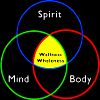
Olympic athletes use visualization to imagine the "perfect execution" of their event. While visualizing, athletes simultaneously "feel" their bodies performing. If you can see it and can feel it, you can transform your body.
A champion's inner voice is positive, encouraging, and instructive. Visualization is a powerful way to become absorbed in the movement experience and to suppress negative emotion.
Don't let negative thoughts creep into your consciousness. The reward will be deep relaxation and a heightened sense of being alive.
Your Health & the Mind/Body Connection
The power of the mind is the key to your most healthy body. Disconnecting from our physical body allows stress to erode our health. Healthy people understand that our minds play a critical role in our physical well-being.
Get The Latest By Email
You can reprogram your mind/body connection and make many positive changes. Utilize the mind/body connection to improve your body's ability to move with ease and efficiency and significantly improve your posture. You will experience fewer aches and pains and have an increased ability to cope with stress.
The ABC Exercise: Action, Belief, Consequence
 Many people believe that the mind and body are at odds. Changing the "inner messages" you give yourself by consciously choosing how you respond to stress is the first step in bringing the mind and body together as a team.
Many people believe that the mind and body are at odds. Changing the "inner messages" you give yourself by consciously choosing how you respond to stress is the first step in bringing the mind and body together as a team.
Action: Begin by picturing a stressful action that happened recently. What was your emotional response to that action? Were you anxious, frustrated, or angry?
Belief: What were your beliefs about that event?
Consequence: What were the consequences or the physiological response of your beliefs? Did you feel your heart rate elevate or your shoulders tense, or did you develop a headache?
We can't always control the stress going on around us. You can learn to modify your internal reaction to stress by interrupting your response between step one, the action, and step two, the belief. More importantly, that choice changes your habitual physiological response or consequence that breaks down your body. You will find yourself less reactive to stressful circumstances, needing to count to ten less often.
Calming Your Nervous System with a Breathing Break
You learn how to implement mastery over your energy levels instead of depletion. This comes from discovering the body's breathing spaces, working your diaphragm, and contracting your abdominal muscles. These tools are for real life and change your inner stress-response messages. Consistent practice builds a "breath savings account" that accrues health dividends for all systems of the body.
Close your eyes and disentangle yourself from outside concerns — and even from the chatter of the mind — to calm down your nervous system. Turn your focus inward and recharge your batteries with a quick breathing break. You can do it behind a closed door at your office, during airplane travel, or just while walking.
You will notice more energy and better concentration through conscious breathing. Anxiety and worry cause our bodies to go on alert. Breathing techniques provide relaxation for mind and body.
This material was reproduced by permission of Quest Books,
the imprint of The Theosophical Publishing House
(www.questbooks.net) ©2012 byLarkin Barnett.
This article was adapted with permission from the book:
Practical Centering: Exercises to Energize Your Chakras for Relaxation, Vitality, and Health
by Larkin Barnett.
 Practical Centering enhances physical, mental, emotional, and spiritual balance with innovative breathing techniques and empowering exercises. It provides an instant vacation in this hectic world, enabling us to elevate our energy, relax our body, strengthen our core, and quiet our mind. Altogether, the tools in Practical Centering can lead to a life of more vitality and ease. It’s a great little book to pack in your suitcase or back pocket. The exercises take only minutes and can be done easily at home, at work, or wherever you happen to be.
Practical Centering enhances physical, mental, emotional, and spiritual balance with innovative breathing techniques and empowering exercises. It provides an instant vacation in this hectic world, enabling us to elevate our energy, relax our body, strengthen our core, and quiet our mind. Altogether, the tools in Practical Centering can lead to a life of more vitality and ease. It’s a great little book to pack in your suitcase or back pocket. The exercises take only minutes and can be done easily at home, at work, or wherever you happen to be.
Click here for more info and/or to order this book on Amazon.
About the Author
 Larkin Barnett is a movement education speaker, Pilates-based physical therapy specialist, professor, movement therapist, dance choreographer, personal fitness trainer and yoga instructor. In 2007, Larkin was chosen as a President’s Challenge Advocate for the President’s Award’s Program, part of the President’s Council on Physical Fitness and Sports. She is the author of Practical Pilates: Using Imagery, Pilates and Calisthenics for Children, Creative Yoga for Children and On a Lark! Creative Movement for Children. Currently, she provides movement education and breathing workshops for adults and children, as well as stress management programs for national fitness conferences, certification organizations, hospitals, corporations, universities, spas, athletic clubs, physical therapy clinics and ballet companies. Visit her website at www.kidsfitnessbooks.com
Larkin Barnett is a movement education speaker, Pilates-based physical therapy specialist, professor, movement therapist, dance choreographer, personal fitness trainer and yoga instructor. In 2007, Larkin was chosen as a President’s Challenge Advocate for the President’s Award’s Program, part of the President’s Council on Physical Fitness and Sports. She is the author of Practical Pilates: Using Imagery, Pilates and Calisthenics for Children, Creative Yoga for Children and On a Lark! Creative Movement for Children. Currently, she provides movement education and breathing workshops for adults and children, as well as stress management programs for national fitness conferences, certification organizations, hospitals, corporations, universities, spas, athletic clubs, physical therapy clinics and ballet companies. Visit her website at www.kidsfitnessbooks.com







